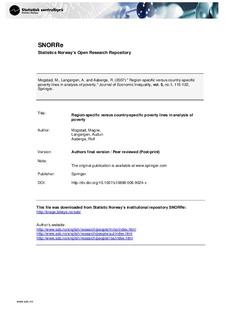Region-specific versus country-specific poverty lines in analysis of poverty
Journal article, Peer reviewed
Permanent lenke
http://hdl.handle.net/11250/177912Utgivelsesdato
2007Metadata
Vis full innførselSamlinger
Originalversjon
Mogstad, M., Langørgen, A. and R. Aaberge (2007): "Region-specific versus country-specific poverty lines in analysis of poverty", Journal of Economic Inequality, vol.5, no. 1, 115-122 http://dx.doi.org/10.1007/s10888-006-9024-xSammendrag
The standard practice in most OECD countries is to identify the poor on the basis of a country-specific poverty line defined as a fraction of the median equivalent income. However, this approach disregards regional differences in prices and needs within a country and may, therefore, produce results that give a misleading picture of the extent of poverty as well as the geographical and demographical composition of the poor. To account for differences in prices and needs, this paper introduces an alternative method for identifying the poor based on a set of region-specific poverty lines. Applying Norwegian household register data for 2001 we find that the national level of poverty is only slightly affected by the change in definition of poverty line. However, the geographical as well as the demographical poverty profile are shown to depend heavily on whether the method for identifying the poor relies on region-specific or country-specific thresholds. As expected, the results demonstrate that the analysis of poverty based on country-specific thresholds produces downward biased poverty rates in urban areas and upward biased poverty rates in rural areas. Moreover, when region-specific poverty thresholds form the basis of the poverty analysis, we find that the poverty rates among young singles and non-western immigrants are significantly higher than what is suggested by previous empirical evidence based on a joint country-specific poverty line.
Keywords: Measurement of poverty, poverty line, heterogeneity in prices and needs
Beskrivelse
The original publication is available at www.springer.com
